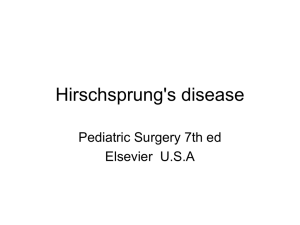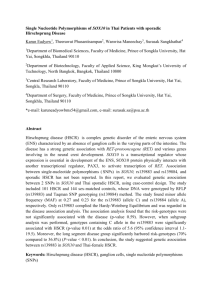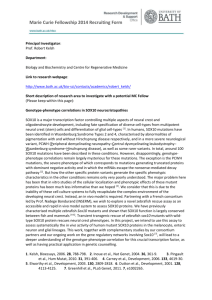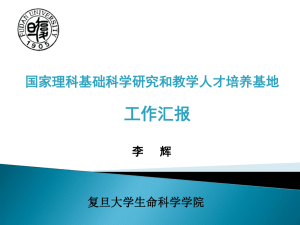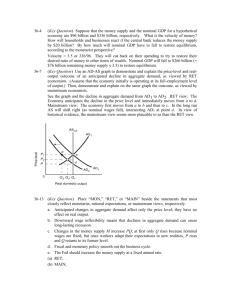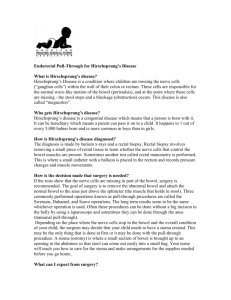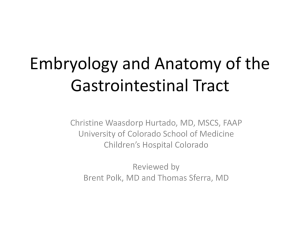Single Nucleotide Polymorphisms of SOX10 in Thai Patients with
advertisement
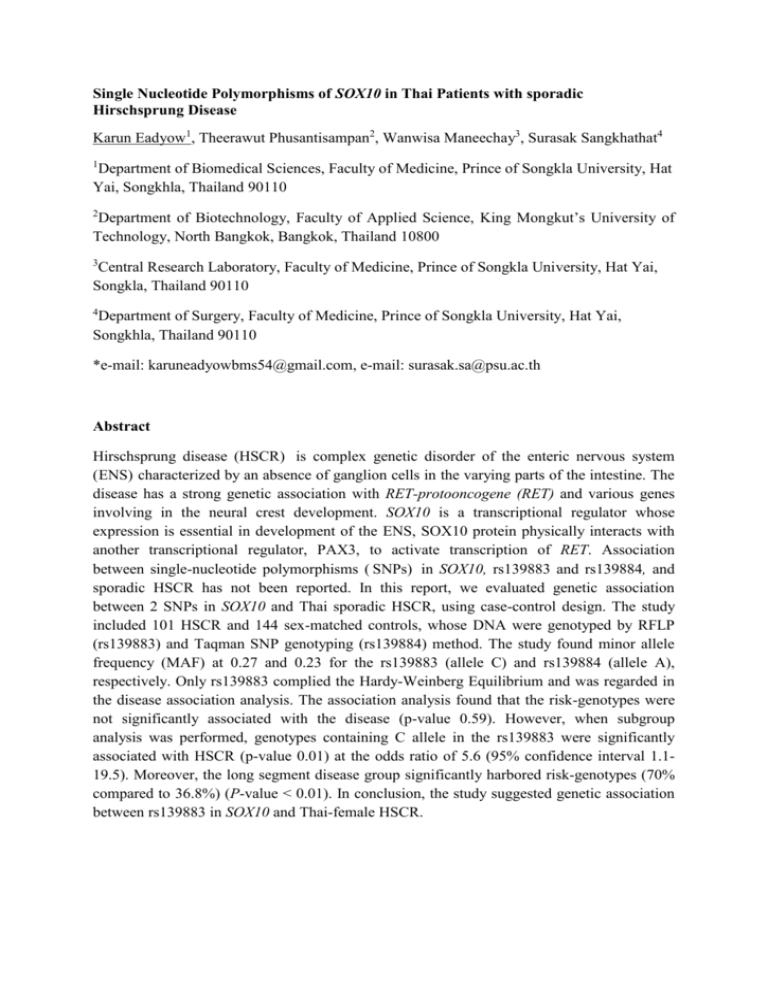
Single Nucleotide Polymorphisms of SOX10 in Thai Patients with sporadic Hirschsprung Disease Karun Eadyow1, Theerawut Phusantisampan2, Wanwisa Maneechay3, Surasak Sangkhathat4 1 Department of Biomedical Sciences, Faculty of Medicine, Prince of Songkla University, Hat Yai, Songkhla, Thailand 90110 Department of Biotechnology, Faculty of Applied Science, King Mongkut’s University of Technology, North Bangkok, Bangkok, Thailand 10800 2 3 Central Research Laboratory, Faculty of Medicine, Prince of Songkla University, Hat Yai, Songkla, Thailand 90110 4 Department of Surgery, Faculty of Medicine, Prince of Songkla University, Hat Yai, Songkhla, Thailand 90110 *e-mail: karuneadyowbms54@gmail.com, e-mail: surasak.sa@psu.ac.th Abstract Hirschsprung disease (HSCR) is complex genetic disorder of the enteric nervous system (ENS) characterized by an absence of ganglion cells in the varying parts of the intestine. The disease has a strong genetic association with RET-protooncogene (RET) and various genes involving in the neural crest development. SOX10 is a transcriptional regulator whose expression is essential in development of the ENS, SOX10 protein physically interacts with another transcriptional regulator, PAX3, to activate transcription of RET. Association between single-nucleotide polymorphisms ( SNPs) in SOX10, rs139883 and rs139884, and sporadic HSCR has not been reported. In this report, we evaluated genetic association between 2 SNPs in SOX10 and Thai sporadic HSCR, using case-control design. The study included 101 HSCR and 144 sex-matched controls, whose DNA were genotyped by RFLP (rs139883) and Taqman SNP genotyping (rs139884) method. The study found minor allele frequency (MAF) at 0.27 and 0.23 for the rs139883 (allele C) and rs139884 (allele A), respectively. Only rs139883 complied the Hardy-Weinberg Equilibrium and was regarded in the disease association analysis. The association analysis found that the risk-genotypes were not significantly associated with the disease (p-value 0.59). However, when subgroup analysis was performed, genotypes containing C allele in the rs139883 were significantly associated with HSCR (p-value 0.01) at the odds ratio of 5.6 (95% confidence interval 1.119.5). Moreover, the long segment disease group significantly harbored risk-genotypes (70% compared to 36.8%) (P-value < 0.01). In conclusion, the study suggested genetic association between rs139883 in SOX10 and Thai-female HSCR. Acknowledgements: The study was supported by a grant from the Faculty of Medicine, Prince of Songkla University. The author thanks all personnel in the pediatric surgery unit, Songklanagarind Hospital for their participation in surgical specimen collection. Keywords: Hirschsprung disease (HSCR), ganglion cells, single nucleotide polymorphisms (SNPs) References [1]Emison ES, McCallion AS, Kashuk CS, Bush RT, Grice E, Lin S, Portnoy ME, Cutler DJ, Green ED, Chakravarti A .A common sex-dependent mutation in a RET enhancer underlies Hirschsprung disease risk. Nature (2005) 434:857–863 [2]Emison ES, Garcia-Barcelo M, Grice EA, Lantieri F, Amiel J, Burzynski G, Fernandez RM, Hao L, Kashuk C, West K, Miao X, Tam PK, Griseri P, Ceccherini I, Pelet A, Jannot AS, dePontual L, Henrion-Caude A, Lyonnet S, Verheij JB, Hofstra RM, Antinolo G, Borrego S, McCallion AS, Chakravarti A. Differential contributions of rare and common, coding and noncoding RET mutations to multifactorial Hirschsprung disease liability. Am J Hum Genet (2010) 87:60–74 [3]Garcia-Barcelo M, Ganster RW, Lui VC, Leon TY, So MT, Lau AM, Fu M, Sham MH, Knight J, Zannini MS, Sham PC, Tam PK. TTF-1 and RET promoter SNPs: regulation of RET transcription in Hirschsprung’s disease. Hum Mol Genet (2005) 14:191–204 [4]Grice EA, Rochelle ES, Green ED, Chakravarti A, McCallion AS .Evaluation of the RET regulatory landscape reveals the biological relevance of a HSCR-implicated enhancer. Hum Mol Genet (2005) 14:3837–3845 [5]Griseri P, Bachetti T, Puppo F, Lantieri F, Ravazzolo R, Devoto M, Ceccherini I .A common haplotype at the 50 end of the RET proto-oncogene, overrepresented in Hirschsprung patients, is associated with reduced gene expression. Hum Mutat (2005) 25:189–195 [6]Miao X, Leon TY, Ngan ES, So MT, Yuan ZW, Lui VC, Chen Y, Wong KK, Tam PK, Garcia-Barcelo M. Reduced RET expression in gut tissue of individuals carrying risk alleles of Hirschsprung’s disease. Hum Mol Genet (2010) 19:1461–1467 [7]Tam PKH, Garcia-Barcelo M. Molecular genetics of Hirschsprung’s disease. Seminars in Pediatric Surgery (2004) 13, 236-248. [8]Sangkhathat S, Kusafuka T, Chengkriwate P, Patrapinyokul S, Sangthong B, Fukuzawa M. (2006) Mutations and polymorphisms of Hirschsprung disease candidate genes in Thai patients. J Hum Genet (2006) 51:1126–1132. [9]Phusantisampan T, Sangkhathat S, Phongdara A , Chiengkriwate P, Patrapinyokul S, Mahasirimongkol S. Association of genetic polymorphisms in the RETprotooncogene and NRG1 with Hirschsprung disease in Thai patients. Journal of Human Genetics (2012) 57: 286–293.
